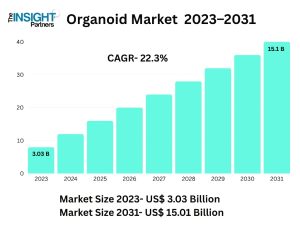
The Organoids Market is undergoing a transformative boom, driven by groundbreaking advances in stem cell research, disease modeling, and personalized medicine. According to recent analysis, the market size is expected to surge from US$ 3.03 billion in 2023 to a remarkable US$ 15.01 billion by 2031, at a CAGR of 22.3% during the forecast period 2024?2031. But what exactly is fueling this impressive growth? Let's explore the key drivers, trends, and innovations reshaping the organoids landscape.
Snapshot: Organoids Market on the Rise
Organoids are 3D structures grown from stem cells that mimic the architecture and functionality of real human organs. These miniature organs are revolutionizing how researchers approach drug discovery, toxicology, disease modeling, and regenerative therapies.Key Segments Fueling Organoids Market Expansion:
- Source Type: Organoids derived from pluripotent stem cells (PSCs) are seeing the highest adoption.
- Applications: Drug discovery, personalized medicine, regenerative medicine, and developmental biology are among the most promising use cases.
Top Growth Drivers of the Organoids Market
1. Growing Demand in Drug Discovery and Preclinical Testing
Pharmaceutical companies are increasingly turning to organoids as highly accurate and scalable models for preclinical drug testing. These models reduce the reliance on animal testing and improve predictions of human response, saving time and costs in clinical trials.2. Expansion of Personalized Medicine
Organoids grown from a patient's own cells allow for tailor-made therapies. This is particularly vital in oncology, where tumor organoids are used to test the efficacy of different treatment options, paving the way for precision care.3. Advancements in Stem Cell Technology
The maturation of induced pluripotent stem cell (iPSC) technologies has enabled scalable and reproducible organoid generation. This has unlocked opportunities in modeling genetic disorders and rare diseases that previously had limited research avenues.4. Integration of AI and Automation in Organoid Production
Artificial Intelligence (AI) and robotic automation are transforming organoid research:- AI algorithms can predict differentiation outcomes and optimize culture conditions.
- Automation ensures high-throughput and standardized organoid manufacturing. This technological synergy is improving reproducibility and accelerating innovation in both academic and commercial settings.
5. Increased Government and Private Funding
Public and private sectors are heavily investing in organoid research. Initiatives such as the NIH's Human Organoid Atlas and EU-funded programs are driving cross-border collaborations, further strengthening the market ecosystem.Regional Insights
- North America leads the global market due to advanced healthcare infrastructure, high R&D investment, and strong biotech presence.
- Europe follows closely, with significant academic research and pharmaceutical activities.
- Asia Pacific is expected to witness the fastest growth, propelled by expanding biopharma capabilities in China, Japan, and South Korea.
- Organoids-on-a-chip: Integration with microfluidics to simulate real organ systems.
- CRISPR-engineered organoids: For gene-editing studies and disease correction.
- Commercialization of organoid kits and services: Making organoid technology more accessible to labs worldwide.







